UNLV Football Offensive Preview
If Cal can't go to Las Vegas, you can always bring Las Vegas to you.
Cal last played UNLV during the 2022 regular season, a 20-14 victory in typical Wilcoxian fashion (jumping to an early lead before desperately hanging on to win thanks to typical Herculean efforts by the defense). Since then, UNLV hired Barry Odom to turn the program around (and who was just hired by Purdue), and turn it around he did. UNLV had their first national ranking since the program moved up to Division I in 1978, as the AP #25 for their matchup against Syracuse. It is their 4th winning season in 30 years, and the first time they’ve had back-to-back winning seasons in 40 years. With a win over Cal in the bowl game, they would tie their school-record for most wins in a season with 11. The last time UNLV had 11 wins was in 1984, which means that Cal losing proves we clearly live in a dystopian novel (and which makes a lot of sense after watching the last 20-40 years of Cal football).
There’s no such thing as the transitive property in football, but Cal and UNLV shared a surprising number of opponents for teams in different conferences: SDSU (Cal won 31-10, UNLV won 41-20), OSU (Cal won 44-7, UNLV won 33-25), Syracuse (Cal lost 33-25, UNLV lost 44-41 in OT). UNLV played a much better game against Syracuse than Cal did, but Cal also blew Oregon State out. None of this matters anymore, especially because of coaching poaching and the transfer portal, but I think it’s fair to say that Cal is more likely to win a defensive battle, and UNLV more likely to win an offensive one.
UNLV’s offense is led by a fast rising coach in Brennan Marion, who is in his first year as an offensive coordinator for UNLV. Brennan Marion has a gold necklace that says “GOGO” which he wears for every game. This is not because of his affinity for Go-Go bars, but because he is the architect behind a new offensive system in which he calls the Go-Go Offense.
But what the heck is the Go-Go Offense, you might ask. Well, that’s why I am proud to introduce a new section sponsored by [INSERT WRITEFORCAL SPONSOR HERE], which I am calling:
Go-Go Offense
Brennan Marion was the offensive coordinator at FCS Howard when they upset UNLV as 45.5-point underdogs in his very first game, the largest upset in college football history. Marion had created a new offensive scheme which he calls the “Go-Go Offense” (named after the uptempo musical style). With most teams now running spread offenses, Marion has gone the other direction: an offense with heavy personnel groupings and running the ball. The Go-Go Offense is fundamentally a triple option offense, with a larger emphasis on pass plays than the traditional triple option.
The triple option is based on the option run, but uses three players who might run with the ball instead of the two used in a standard option run. Under Marion, the UNLV triple option will often have multiple players touching the ball and lining up in unbalanced formations.
The quarterback will run a lot of RPO (run-pass option) plays, where the QB has options (e.g. hand it to the running back, keep it, etc). They will also run a lot of Pin and Pull plays (especially out of unorthodox formations), such as a 2-back set with one back leading, the tight end blocks, and another back pulls around. With the running game going, it will open up vertical shots down the field.
I tried to take a few clips through their season that demonstrated some of these concepts. Here UNLV runs a popular triple option play called outside veer:
Here UNLV has an unusual formation with two running backs lined up to the same side of the quarterback, it looks like an option play, but they instead flip it to a receiver on the reverse:
And of course, after seeing the fullback block for every single play, it catches the defense by surprise that he is also an eligible receiver:
The RPO game is a big part of the offense. After handling the bad snap, the quarterback recovers the ball and keeps it on the run, with one of the backs in the backfield becoming the lead blocker:
UNLV also ran a lot of pin-and-pull plays, but the players that pull are sometimes unexpected. Here the right guard and the fullback pull to set up the blocks downfield for the running back to follow:
UNLV has one of the highest percentages of run plays in the FBS (7th, 63.11% of plays are runs). With defenses anticipating runs, it opens up the downfield passing game, and UNLV will take deep shots down the field:
The uniqueness of the offense is one of its strengths, as defenses aren’t used to defending against it, and are thus more likely to make a mistake when they run into a situation that they are not used to seeing. This should be somewhat offset by the fact that Cal has a longer time to prepare for the bowl game than they may have had for a traditional midseason matchup.
Quarterback
The starting quarterback through the first 3 games of the season was Matthew Sluka, who made national headlines for his decision to leave his undefeated team over a dispute with NIL payments. Stepping in to replace Sluka was Hajj-Malik Williams, a transfer from Campbell (and who transferred there from West Point before that). QB Hajj-Malik Williams learned the triple option offense at West Point before transferring to Campbell, where he then ran an offense compromising of a mix of zone read, RPO, and quick passing style plays.
Hajj-Malik Williams is dual-threat quarterback currently averaging 167.7 passing yards and 74.9 rushing yards per game, with 17 passing TDs and 9 rushing TDs. Williams’s ability to run the ball is what opens up the passing game, as UNLV looks to take deep shots down the field for explosive chunk plays.
Although Williams doesn’t have the strongest arm and often puts a bit too much air under the ball, he’s decently accurate on his downfield shots:
Here Williams does a great job of dropping it in to his receiver (although he wasn’t able to complete the catch):

Although Williams prefers to work the middle of the field and doesn’t typically throw many of these, here’s an example of a throw with some nice placement on the back shoulder:
Although I typically try to save this for the appropriate section, I just have to mention his primary receiver, Ricky White III. Hajj-Malik Williams had the same trainer as WR Ricky White III, who recommended him to Brennan Marion and got him over to UNLV. Unsurprisingly, it looks like these two have been playing together for ages, as Williams has great chemistry with White and targets White a ton (White leads the team with 124 targets out of 283 total for the entire team). Williams is in sync with White, and will make accurate throws on timing routes to White:
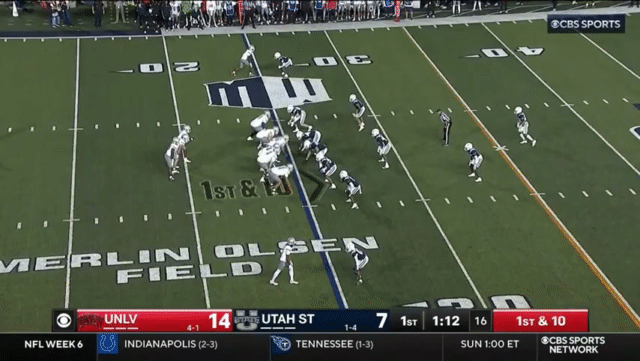
Here’s another example showing that Williams knew exactly where to place the ball for White to get it:

Here’s another accurate throw with good anticipation:
Although Williams isn’t the type to rely purely on arm strength, here is an example where he made a nice throw on the run:

What really makes Williams dangerous is his running ability, which is to be expected from someone who can run the triple option. Here the first defender to the ball gets frozen by the RPO handoff, and the second defender plays the option pitch, and Williams makes them pay with a huge run:
Williams will regularly rely on his legs to keep drives alive, and will often run for the first down:
And again:
The following play is just a great run, showing both his speed and cutting ability to beat defenders:
Williams is elusive in open space, both in his ability to evade sacks and in his ability to run the ball:
Williams’s running ability can freeze the defense and open up the passing game. Watch how many defenders get sucked in to defend the run:

Williams has also shown great improvisational skills with the ball. Here he easily dodges the free rusher before running for the first down:
Snaps have been a recurring issue for UNLV (to be discussed more later), but Williams will recover the snap and often turn it into a big play anyway:
Here he turns another errant snap into a touchdown:

Williams survives yet another sack attempt through sheer will and makes multiple tacklers miss in open space to turn what should have been a negative play into a positive one:
Williams won’t often challenge defenses with difficult throws (e.g. throwing into a tight window), and he probably won’t pick apart a defense as a pure pocket passer. He can struggle with accuracy:
Even with time to throw, good protection, and in a situation in which a risky throw is perfectly acceptable (risk-averse quarterbacks may avoid turnover-worthy throws, but on 4th and goal you absolutely should be taking risks as an interception here costs you nothing), he still was unable to make the throw:
Here’s a pure arm strength throw, which results in an underthrow for an interception:
UNLV does not have a high success rate throwing it deep down the field. On the following deep ball, it’s a bit underthrown, which forces the receiver to slow down for it, allowing the defender to make a play:

And this one just isn’t an accurate throw to an open receiver:
Most of the decisions Williams has to make are run-based. I don’t have a ton of examples of him surveying the field to make a great passing read:
UNLV’s offense is heavily run-based, so being able to disrupt the run and force Williams into obvious passing situations would be beneficial. However, Williams can still viably run the ball on 3rd and 15, so I am not quite sure if “obvious passing situations” are even possible.
Running back
UNLV is a running back by committee team, which should not surprise you given how often UNLV runs with multiple backs. I usually try to organize my sections by which players I think will have the biggest impact on the game, but here I will start with who I think is their most dangerous player (even if he won’t get the most touches): the freshman Las Vegas native, Greg Burrell (update: he entered the transfer portal, so I’m not clear if he’ll even play). Burrell is the most talented back on the roster, and the most dangerous on the ground. Even with limited touches this year, he had the most highlights:
Look at this cut he makes to break off a big run:
Burrell does a good job of not going down on first contact, keeping his balance to keep running after breaking a tackle:
And again he gets tripped up, but regains his balance to fight for extra yards:
The running back likely to get the most touches is Jai’Den Thomas, who coincidentally also goes by the nickname “Jet Thomas” (even though Cal’s Jet Thomas is obviously better). Jai’Den Thomas is listed at 5’9” and 180 lbs, which makes him difficult to see sometimes as he follows his offensive linemen blockers. Here he does a good job of keeping his balance and seemingly emerges out of nowhere to get free for the touchdown:
Although Jai’Den Thomas doesn’t have elite breakaway speed (unlike the real Jet Thomas), he can be slippery in the open field, most often resorting to a spin move:
And again:
…aaaand again:
Although he’s not a big guy, Thomas has shown some surprising success with the stiff-arm:
The more traditional power back is Kylin James. Here he runs through contact on his way to the endzone:
As a bigger back, he’s not known for his speed, but he did break off this one big run (which looks a lot like how I would run after some McDonald’s):
James also loves the stiff-arm:
And this one is even more brutal:
There is also the freshman Devin Green who may get some more touches in Burrell’s absence:
Offensive line
I decided to add this section late, and so I didn’t do a terribly great job of watching offensive linemen for UNLV as I went through their games. However, most of the big plays from running backs this season were set up by excellent blocks by offensive linemen (as well as other players downfield). The last time Cal played UNLV, their offensive line was a mess, but they have evidently made significant strides since then.
This run is set up by a huge hole opened by the interior of the offensive line:
Here’s one with some pullers along the offensive line to help Thomas get free:
And another pin and pull play (on a very rainy day which made passing very difficult and running the ball expected), showing how a lot of UNLV runs are schemed by the offensive more so than individual effort:
And here is just a bunch of nice blocks (including one by WR Ricky White III):
Here the UNLV offensive line pretty much forms a wall of blockers to help James get to the next level of the defense:
And again:
Even though I regret not doing a better job to highlight the individual victories by the offensive linemen, I felt that the unit as a whole merited discussion, as it is their play that has really been key to the success of the run game. As a final note, however, I have to mention the struggles they’ve had snapping the ball this year. QB Hajj-Malik Williams often does a great job of recovering from errant snaps, but it’s not always the case, and bad snaps may cause an issue for UNLV:

Receivers
There’s no question who the star of the show is here: WR Ricky White III. I was really impressed with him when I first saw him prior to the matchup against Cal in 2022 (in case you don’t remember my preview at the time: https://writeforcalifornia.com/i/71149638/receivers). I don’t want to completely rehash what I said at the time, but it’s all still true: Ricky White III is fast, an excellent route runner, and shows great body control on contested catches. White is absolutely an NFL talent who is probably underrated on the national scene. It’s not at all surprising that nearly half of the teams pass attempts are headed White’s way. He’s difficult to cover because of his ability to get open through his routes:
He’s difficult to cover in single man coverage because of his ability to win on routes:
And here his speed helps him get some separation as well":
Here White gets wide open and then does a great job extending himself to haul this one in for a touchdown:

White has the quarterback’s complete trust, and QB Hajj-Malik Williams will absolutely throws some “screw it, White is down there somewhere” passes. Here White is well-covered but makes the contested catch anyway:

Here White again makes a catch over the defender:
Of course, White is also dangerous in the open field with some nice YAC ability:
Here he uses his quick change of direction ability to juke a tackler:
White should also get NFL looks for his abilities on special teams (which we will see tomorrow). He’s not the biggest-bodied receiver, but he is particularly dangerous on routes where he can get a free release.
Although White has almost 3 times as many targets as the next most targeted receiver, Jacob De Jesus, you will still see De Jesus get plenty of touches as well. Jacob De Jesus is listed at 5’7”, but he’s known for his speed as well as his versatility: the receiver has also played running back, and will often be featured in the run game:
UNLV loves to work the middle of the field, which is De Jesus’s bread and butter:
Here De Jesus shows some nice body control in both making the catch at the sideline and being able to tap his toes in bounds for the touchdown:
UNLV will often use De Jesus when they run the jet sweeps, reverses, etc., because he is dangerous in open space:
Here he is on a reverse:
UNLV’s big target possession receiver is the tight end, Kaleo Ballungay. Here he makes a nice run after the catch:
And here he makes a nice catch over the defender:
Although Ballungay doesn’t have a ton of targets (roughly 1/6 of White’s targets with 23, which still makes him the 3rd most targeted receiver behind White and De Jesus), he’s shown some nice receiver skills as well:
Here Ballungay is trusted to make the contested catch in traffic:
Although he’s not a starting receiver, Jaden Bradley has seemingly picked up a thing or two sitting behind Ricky White:
He’s shown an ability to make good adjustments to the throw:
And he’s also shown that he can make a catch in coverage:
The other outside receiver across from Ricky White III is Casey Cain. Although Cain has had some issues with drops, here he makes a nice diving catch:
And here Cain makes the catch through the physical coverage:

I haven’t seen enough of sophomore Corey Thompson (4 receptions), but this was one of them, and it was nice:
The backup slot receiver is DeAngelo Irvin Jr., who was a high school quarterback, a skill used in the following trick play:
Although the Cal secondary has always been pretty good at taking away a team’s top receiver, Ricky White III will be a difficult player to cover all game long and will most certainly get his fair share of opportunities.
Conclusion
UNLV’s offense is significantly different than any other offense that Cal ahs faced, which poses its own unique challenges. QB Hajj-Malik Williams can move the ball through the air or on the ground, but UNLV has had some trouble scoring in the redzone. UNLV is also one of the best teams in converting turnovers into points, and their special teams do a great job of giving them great starting field position so that they have a shorter field to work with. I’m expecting this to be a low-scoring defensive struggle now that Fernando Mendoza has left the program. The Cal offense and its quarterback will be a huge question mark, but they will need a quarterback who can piece up the UNLV secondary while hoping the offensive line can hold up against a strong front-7 for UNLV. If the game is indeed a low scoring defensive battle, UNLV’s special teams may give them the edge in this one. If after the game, you don’t notice anything about UNLV’s special teams, note that itself would be a victory for Cal. Stay tuned for the defensive article tomorrow.
Go Bears.
You can find my full clips here.






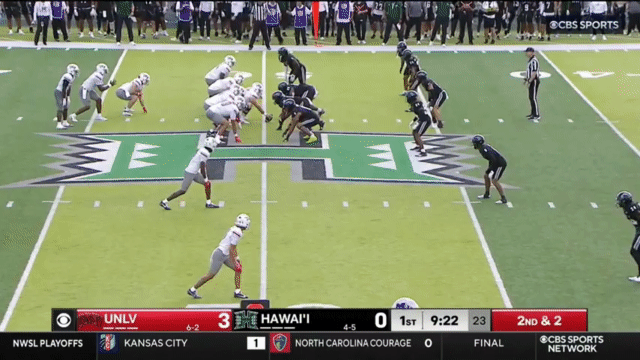


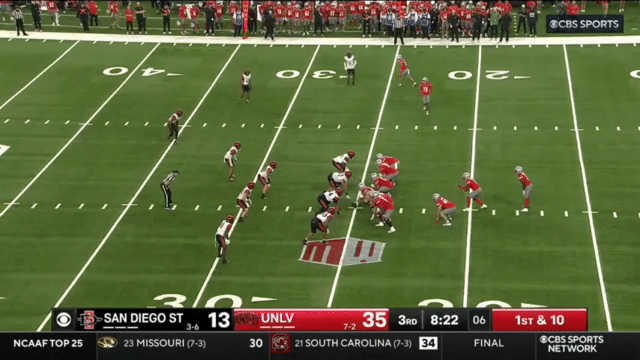



















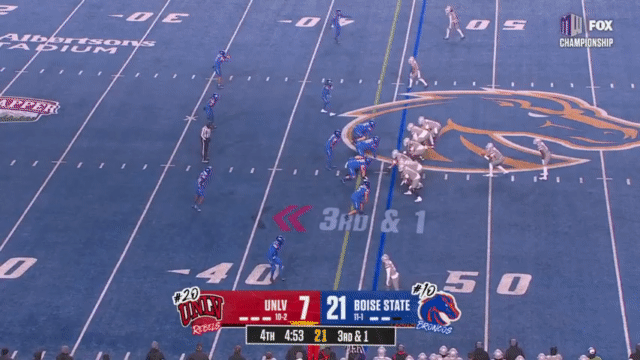
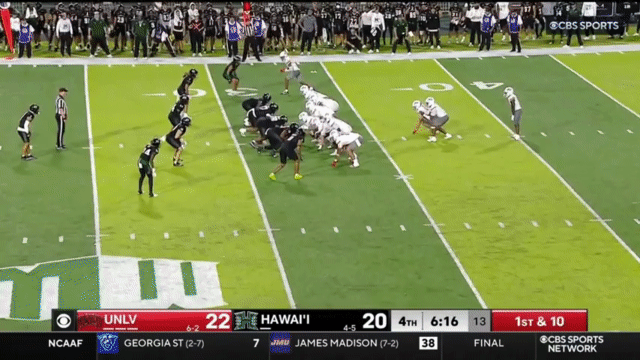









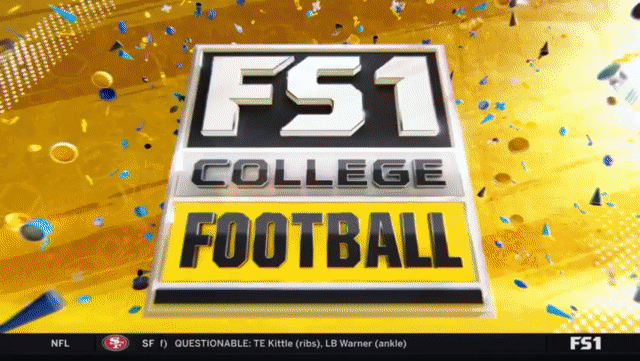



















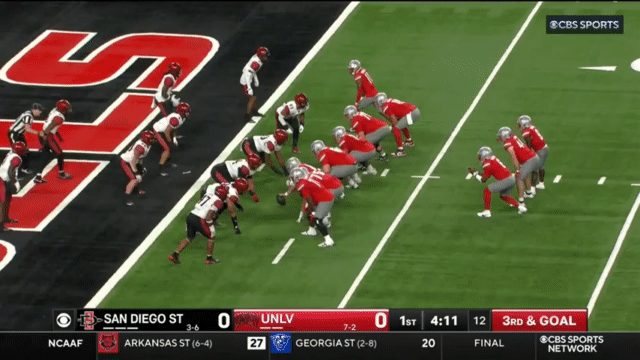






It might be the hopium talking as I have no empirical data to back this up, but I believe Cal will be able to run the ball on Wed. CJ Harris will start and Jet will have a big game.
With all the changes over the last week, this becomes a very important game for Cal. In order to attract upper level portal/HS talent, they need to show recruits they are a few key players away from getting to 9-10 wins. It can be done! Go Bears!
I appreciate the in-depth preview, Nick. This bowl game looks to continue a history of crazy bowl games under Coach Wilcox. And once again I really have no idea what to expect. Go Bears!